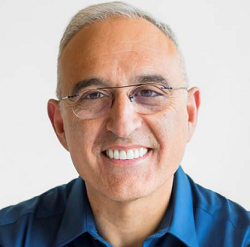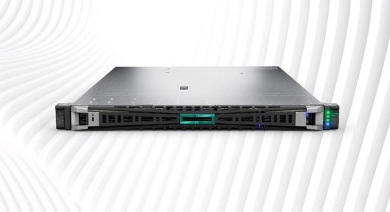HPE Pushing IT as a Utility Model, with Hardware as a Facilitator

HPE is positioning itself to be a utility company for IT, with more revenue derived from services, and the hardware and infrastructure playing a background role as a facilitator.
"The majority of the margins will be services and software," said Antonio Neri, CEO at Hewlett-Packard Enterprise, responding to questions from EnterpriseAI during a press conference at the Discover tradeshow being held in Las Vegas this week.
"The vision is very simple,” Neri said, “the infrastructure piece of this is nothing more than a cost of the sales," he added.
HPE is placing a big bet on its GreenLake platform, which it introduced four years ago as a way for companies to implement a hybrid cloud strategy. The platform includes hardware, software and services.
GreenLake dominated the tradeshow floor, which also focused on pushing IT to organizations more as a utility, much like electricity to homes, with the services being consolidated into fewer bills. HPE’s customers can rent the GreenLake services and pay-as-they-go, with HPE managing the hardware, middleware and services.
Customers have a choice on their level of engagement with GreenLake, with HPE taking over management, deployment and providing the connected tissue to data and software assets that may reside on public clouds or other repositories.
The big announcement at the show was GreenLake Private Cloud Enterprise, a private cloud service that can be fully managed by HPE. The offering includes the hardware, software and services, and can be installed in private infrastructure or hosting services like Equinix or Digital Realty. The pricing model is much like the public cloud offerings, and customers can pay as they go.
The offering is an important step for HPE to build a subscription model across a wider swathe of its businesses that engage the company’s infrastructure, storage, networking and compute offerings. Many years ago, those hardware offerings were at the forefront of HPE’s offerings, but are increasingly being rolled into the GreenLake offerings.
There are many ways to charge on subscription services in GreenLake, Neri said. The components could include network-as-a-service or storage-as-a-service, but a majority of the margins will come from software-as-a-service, with the hardware pieces "being the cost of goods sold," Neri said.
HPE has stressed GreenLake as an "edge-to-cloud" offering, which is a similar approach taken by public cloud providers Google, Amazon and Microsoft.
The public cloud providers are adding hardware -- which was traditionally focused in their mega data centers -- to the endpoints on the edge to facilitate collection and processing of data.
GreenLake is HPE's way of managing the hybrid cloud, and it competes with offerings such as Amazon's Outpost, and Google's Anthos. But HPE's rich history of personalizing systems to the requirements of a customer gives it an edge over the public cloud providers, which are largely reliant on commodity hardware.
"That's how HPE is taking GreenLake to market. Like, 'yeah, we'll work with you for whatever hardware needs you have. We will extend to that.’ That model requires a decent amount of software to pull off. It requires software integration," said James Sanders, research analyst at 451 Research.
The older hardware-centric billing strategies of per-CPU core usage don't make sense anymore, and software-as-a-service makes more sense.
"If all of the software that you're purchasing is delivered in a SaaS model, you don't really have to worry about the hardware lifecycle, because you're not tying that license to a physical server," Sanders said. "Servers had four cores. Today, the server has 128. Right. And that becomes a very different financial question."
HPE at Discover introduced a 128-core ProLiant RL300 Gen11 server, which has Arm-based chips with 128 cores from Ampere Computing. Software partners already on public cloud also announced their offerings on GreenLake. Nvidia, for example, said it would offer its Enterprise AI software platform on HPE GreenLake.
IT environments are getting compex with expansion of cloud to the edge, HPE’s system-builder heritage gives it the ability to understand the granular requirements of customers and meet the last-mile requirements on the edge, where computing resources are smaller in size, said Keith Townsend, an analyst at consulting firm The CTO Adviser.
"HPE has a tremendous advantage. They are not a centralized solution. If you have complex distributed challenges, what we call the edge or in the data center, Google, AWS and Azure are not really well positioned," Townsend said.
But many of HPE's customers still don’t understand where the company is going or what it is doing, Townsend said.
"HPE is trying to do something that's really hard, which is to take what we would consider traditional infrastructure and deliver it as a cloud service. But you don't consume it in the exact same way you would consume a cloud service. It is traditional enterprise IT managed by HPE, it is consumed as a service, which is different than the cloud," Townsend said.
A couple of years ago the idea of cloud-first was different, and people are realizing that moving everything to the public cloud is good for some, but not for all, said Fidelma Russo, CTO at HPE in response to a question from EnterpriseAI during a press conference.
Many companies are taking computing resources in-house to meet privacy and regulatory requirements. For example, medical companies may look to run electronic medical records in-house due to regulatory requirements. Also, some countries require that customer data be stored on servers located in the country.
“With our logistics network, with our knowledge of what it takes to build highly efficient compute and storage that sits on the small footprints in certain areas, I think that's actually a powerful advantage," Russo said.
HPE is still peeling the onions on its transformation strategy, and it is now resonating in the company results, said Crawford Del Prete, president of IDC.
In the most recent quarter, HPE revenue was $6.7 billion, growing by just 1.5 percent compared to the same period last year. But GreenLake and the services business were bright spots, with the GreenLake customer bookings accounting for more than $6 billion in the balance sheet, growing by 107% year-over-year, and the third quarter in a row in which the orders more than doubled.
"Our mix of GreenLake is shifting every single quarter to more software and services, which obviously comes with a significantly higher margin than just the hardware," Neri said.
HPE's compute division still accounted for a majority of the revenue, totaling $2.99 billion, which grew by just 1% year-over-year. The fastest growing division was the intelligent edge, which is closely associated with GreenLake offerings, with revenue growing by 9% year-over-year to reach $867 million. Revenue from HPC and AI was $710 million, growing by 5%. (The Frontier supercomputing revenue is not in yet.)
The company hopes to expand the presence of GreenLake through its resellers, who have traditionally sold hardware and other gear. Resellers are still not used to the change in business model, but HPE is trying to convince resellers that they can add their own value.
"They can choose to build, resell, or manage on behalf of customers," Neri said.












